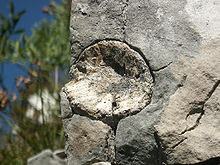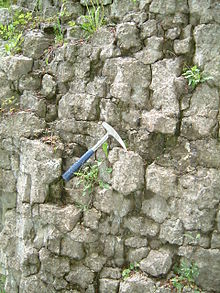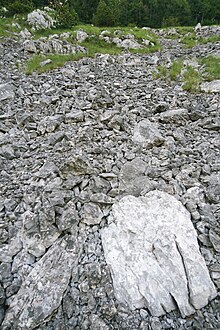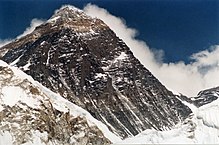limestone

As limestone are sedimentary rocks denotes the predominantly of the chemical substance , calcium carbonate (CaCO 3 ) in the form of the minerals calcite and aragonite exist.
Limestone is an extremely variable rock; this concerns both its formation and its properties, appearance and economic usability. There is therefore a special field of its own within geology , carbonate sedimentology , which deals exclusively with the formation and properties of the various types of limestone. Most limestones are of biogenic origin (formed by living things), but there are also chemically precipitated and clastic limestones.
Limestone is of enormous economic importance as a raw material for the construction industry and as a natural stone . Such deposits are also storage rock for crude oil and natural gas.
Not one of the limestone in the strict sense are metamorphic rocks such as marble and igneous rock such as Calcitkarbonatit counted, although they also predominantly of calcite or other calcium carbonates exist.
Disambiguation
The term limestone is used differently in colloquial language as well as in technical and scientific terminology. While the term is used relatively comprehensively in scientific language and, in addition to the strongly consolidated limestones, also relatively crumbly rocks such as chalk are assigned to the limestones, the term in the building materials industry is rather restricted to strongly consolidated limestone.
Furthermore, in the stonemasonry and stone carving trade and in the natural stone industry, polishable limestones are often referred to as "marble", although they are not marbles in the geological sense . Marble is a metamorphic rock in geosciences .

composition
Limestone consists mainly of the minerals calcite and aragonite , two crystallization forms of calcium carbonate ( carbonate calcium CaCO 3 ). Other minerals occur in more or less fluctuating proportions. These include clay minerals , dolomite (CaMg (CO 3 ) 2 ), quartz , gypsum and others. If the proportion of dolomite predominates, it is called dolomite stone . If the limestone has a relatively high proportion of clay minerals, it is called marl . Limestone can also contain up to several percent organic matter and is then called bituminous lime ( also called stink lime if hydrogen sulfide is present).
properties
Limestone is typically light, white to ocher in color, depending on the content of manganese , iron oxides and other colored minerals.
With a hardness according to Mohs = 3, limestone is relatively soft.
The density of dense (= non-porous) limestone is 2.6-2.9 kg / dm 3 .
Formation of limestone
Limestone can be of several types within sedimentary rocks . The majority of the limestone is of biogenic origin, which means that it was formed and deposited by living things. Limestone can also be precipitated from the water by chemical processes (which in turn can be influenced by living things) . Furthermore, a rock consisting of calcium carbonate (limestone or marble) can be removed, transported and deposited again in another place as clastic sediment.
Biogenic limestone

If it is of biogenic origin, limestone is usually deposited by microorganisms or stony corals . Limestone is also to be found subordinate, which mainly consists of snails , mussels or sponges . In any case, the rock consists of calcium carbonate, which was a component of living beings and was deposited to build external or internal skeletons .
Limestone deposited by microorganisms
Limestones deposited by microorganisms - including chalk - are usually fine, microcrystalline sedimentary rocks that are formed by the deposition of shells of fossil microorganisms, especially coccoliths of coccolithophores and shells of foraminifera . Lime-separating algae and bacteria ( stromatolites ) can also form rock. Because of their often massive structure, they are also known as mass limestone . You can also find precipitated calcite in the rock , so that there are flowing transitions to the precipitated limestone. Macrofossils can be seen with the naked eye, more or less frequently and often tied to narrowly defined locations, which thus indicate transition stages to the fossil limestone.
The rock is formed when the shells sink to the ground after the death of the living creature and initially form what are known as lime sludge. Lime sludge can only form up to a certain depth in the open ocean. Below the so-called carbonate compensation line, the calcium carbonate is completely dissolved due to the water pressure, so that the sediments below this line are always carbonate-free. The depth of the carbonate compensation line varies; in the tropics, for example, it is between 4500 and 5000 meters water depth.
The diagenesis of the sludge then creates solid limestone. New calcite crystals form during solidification. Most of the originally present aragonite is converted into calcite. Cavities can be filled with later (secondary) formed crystals or the existing sediment structures can be more or less completely blurred by strong recrystallization.
Fossil limestone

Fossil limestone is the name given to rocks or layers within otherwise massive limestones, which for the most part consist of fossils that are visible to the naked eye. Coral limes are most common worldwide , as their growth on coral reefs can give rise to significant rock thicknesses. Other, often found Fossilkalke be named after their (main) Rock formers Molluskenkalk , foraminous (also nummulite ) Brachiopodenkalk , Bryozoan , Goniatitenkalk , Crinoidenkalk or other animal groups. Nullipore lime is produced by lime-separating, multicellular algae. Rock from mussel shells is known as mussel limestone or, if the structure is very clearly visible, mussel schill .
With the fossils preserved in limestone, a distinction is made between communities and burial communities . Biological communities represent the organisms occurring on site and are embedded in the sediment immediately after their death or are already embedded as living beings living on the ground. Grave communities are transported by currents and other transport mechanisms and deposited again at a suitable location (e.g. stream shadow). The creatures it contains have mostly not inhabited a biotope .
While coral and other reef limestones are already quite solid limestones, the other fossil limestones first undergo a diagenetic hardening similar to the mass limestone discussed above. Subsequent recrystallization can change all fossil limestone, including reef limestone, significantly.
Chemically and biogenically precipitated limestone

Naturally occurring water (both sea and fresh water) always contains calcium hydrogen carbonate in more or less large quantities . As described in the linked article on this substance, it is in chemical equilibrium with calcium carbonate, carbon dioxide and water. If more calcium carbonate gets into the water (but no more carbon dioxide, which is a prerequisite for the formation of the hydrogen carbonate), the equilibrium shifts to the side of the calcium carbonate, which precipitates due to its low water solubility . Calcium carbonate produced in this way was not previously a component of living beings. Limestone can thus be part of evaporite series . Limestone occurs within the evaporation sequence because of the comparatively low solubility of calcium carbonate at the base of the series of rocks. He is the first to be deposited. This is usually followed by gypsum and above it the easily soluble salt rocks, for example rock salt . In the sea, calcite crystals can only be deposited in the uppermost 200 m, as the solubility for carbon dioxide increases at greater depths due to the increasing water pressure and the above-mentioned chemical equilibrium shifts entirely to the side of the easily soluble calcium hydrogen carbonate. Calcite crystals can, however, sink to the carbonate compensation line defined in this way .
The precipitation of calcium carbonate can take place completely without the participation of living things, but is mostly supported by the activity of living things (especially algae, in fresh water also mosses). The photosynthesis of the plant consumes the carbon dioxide in the water, whereby the above-mentioned chemical equilibrium also shifts to the side of calcium carbonate, which is now enhanced as calcite precipitates out of solution.
The calcite is precipitated both within the water column and at the bottom of water bodies directly on the subsurface. In the first case, microscopic crystals form in the water body , which sink to the bottom and also form lime sludge there. Their diagenesis then results in a solid limestone. In the second case, the calcite crystals grow directly onto other crystals on the bottom of the water, so that they can also settle in rivers. This mechanism is necessary for the creation of travertine or tufa .
The chemically precipitated limestones also include the calcareous oolites , in which the carbonate is deposited concentrically around crystallization nuclei.
Clastic limestones
Clastic sedimentary rocks can under certain conditions consist almost entirely of calcium carbonate and are then usually referred to as limestone. Strictly speaking, they should be classified into one of the categories of clastic sediments. Usually these sediments have a large grain size, since smaller particles quickly destroy carbonate. Likewise, due to the low mechanical and chemical resistance, the grains were usually only transported over short distances. Most widespread are so-called reef slope breccias, in which broken, mostly angular reef material accumulates at the foot of a coral reef. Petrographically, it is more of a breccia than a limestone. A special case is calcarenite , in which fossil fragments are mixed with fragments of other limestone that formed in marine shallow water zones. In some cases an even finer-grain micritic mass binds the small clasts.
Classification of clastic limestones (according to the average grain size):
Appearance
In most cases, limestones are light, gray to gray-yellow in color. Due to the addition of other minerals (for example iron compounds), stronger, especially red colors appear quite often. Bituminous limestones can also be dark gray to black in color. Chemically precipitated limestones or limestones deposited by microorganisms are usually fine-grained and dense. Depending on the formation conditions, fossils can be found there more or less often. Fossil limestone, on the other hand, has numerous easily recognizable fossils. These limes often contain pores and other cavities. Extremely large cavities contain freshwater limestone, travertine or tufa.

ID
In practice, limestone is detected using 10% hydrochloric acid in the so-called carbonate test (lime test). If a drop of hydrochloric acid is placed on a limestone, it becomes very hot. Carbon dioxide is released. In the case of dolomite , the same experiment does not bring any effervescence. The formation of bubbles in dolomite is only visible under a magnifying glass. If hydrochloric acid is heated on dolomite, then this also roars. With this, limestone can be separated from dolomite in nature using a simple method and limestone can be clearly identified. The total calcium carbonate content of a sedimentary rock (or calcareous soil) can be determined with the so-called carbonate determination according to Scheibler with special equipment in the laboratory.
Weathering of the limestone
Karst and freshwater limestone
Because of the comparatively good solubility of the carbonate, limestone is a rock that is relatively susceptible to chemical weathering and therefore forms special forms of solution. Conversely, the dissolved carbonate can be precipitated again and also produce special rocks and shapes (tufa, limestone , travertine). Both are summarized under the name karst or karst .
A characteristic soil type develops on the limestone exposed to weathering, the rendzina . If limestone is weathered underground, caves are created . Stalactite caves are formed in the interplay of various factors . The stalactites in these caves grow as limestone sinter .
Physical weathering
Limestone weather easily under subarctic and arctic climates as well as in high mountains by means of frost blasting and then forms cataclastic breccias. The brittle stone is susceptible to alternating frosts and high humidity. It weathers to periglacial layers like those recently found in the high limestone mountains and more rarely in flat areas in the arctic latitudes. Periglacial limestone debris collects on northern slopes or in shaded hollows; it is angular and shows hardly any signs of chemical weathering due to the climate. Lime debris in the high mountains is only populated by plants when it is calmed down. These follow a succession which in the Alps leads either over the limestone rubble or limestone snow valleys Flora over espalier bushes to mountain pine bushes.
Economic use

Depending on their properties, limestones are extremely versatile. Dense limestone in particular is used as an easy-to-work natural stone .
Limestone is one of the most important raw materials for the building materials industry. For this it is processed in lime works and converted into quicklime . Depending on the deposit, the limestone behaves differently when it is burned in terms of kinetics, energy consumption and the resulting quicklime quality. Or it is ground and mixed with clayey materials burned to cement, which is the binding agent for the production of concrete (mixture of cement, water and aggregates such as sand and gravel). Limestone is also used in the glass industry because it introduces calcium into the glass melt.
Limestone is used as carbonate for flue gas desulphurisation . Finely ground limestone is used in agriculture and water management to prevent the acidification of soil and water. The calcium compound is used as an aggregate in the glass industry and for slag formation in the metallurgical industry. Because of this composition, limestone is also used as a fertilizer .
Very pure limestones (white lime) are raw materials for the chemical industry or are processed into terrazzo (Ulm white lime).
Porous limestones, especially fossil limestone, are one of the most important storage rocks for oil and natural gas . The richest oil deposits on earth on the Arabian Peninsula are located in reef limestone that was formed in the Jurassic and Cretaceous periods . That is why limestone serves as an indicator when prospecting deposits.
Lower quality limestone, which was normally considered a waste product, has been increasingly used in the manufacture of stone paper in recent years .
Occurrence
General
Limestones are very widespread rocks on the continents and shelves. According to Paul Williams and Derek Ford, carbonate stones take up 10-15% of the non-iced land area. They can be found both on relatively old geological tables and in geologically young mountains . However, within the very ancient shields and deep sea basins, they recede. Most of the limestone was originally formed in the (shallow) sea and raised above sea level by tectonic processes. Terrestrial limestones (formed on the mainland) almost always require older limestone deposits in the vicinity, which are necessary as a delivery area for the calcium. For example, the tufa deposits in Thuringia are always linked to the presence of limestones from the shell limestone.
Limestones are particularly widespread in the northern hemisphere, while the old Gondwana continents have relatively small deposits, except at their margins, where there are also extensive, more recent Cretaceous limestone series such as the Nullarbor Plain in Australia. Carbonates can be found in all latitudes and at all heights of the earth's surface, from northern Siberia and the Arctic Canadian Shield to Mount Everest as well as Florida and Papua New Guinea. The summit of Mount Everest is mainly made of limestone.
Europe
Large deposits of limestone can be found in Central Europe in the central and southern part of Germany (mainly limestones from the Muschelkalk and the Upper Jura), in the Swiss and French Jura, and in the northern and southern Alps . Furthermore, limestones can also be found very frequently as Ice Age debris in northern Germany. The limestone rubble comes mostly from southern and central Sweden and from the central and northern Baltic Sea basin.
Large landscapes that are predominantly characterized by limestone are, for example, the Swabian and Franconian Alb , as well as the northern limestone Alps or the coast of Dalmatia . The most famous mining area in Germany is in the Altmühltal with the Solnhofen limestone and Jura limestone .
Significant travertine deposits are located in Germany, for example, in Stuttgart-Bad Cannstatt and in the Thuringian Basin (e.g. Weimar-Ehringsdorf).
Chalk emerges in numerous locations along the European chalk belt. The belt stretches from Great Britain via France to the central Baltic Sea and is also being dismantled in places.
Limestone has been mined at least since Roman antiquity, for example on the island of Brač (building material for Diocletian's Palace in Split ). One of the oldest limestone quarries in Germany is the historic Rüdersdorf limestone quarry in Brandenburg , which dates back to the work of the Cistercians in the 13th century.
Egypt
In ancient Egypt, limestone was used as a building material for the mastaba tombs since the first dynasty and for the pyramids in the third to sixth dynasties . The less good, mostly porous limestone was used for foundations and core structures, the mostly white, fine limestone from the eastern bank of the Nile from Mokkatam and Tura for external cladding. A detailed determination of the ancient Egyptian limestone quarries was made by Dietrich Klemm and Rosemarie Klemm .
Special forms of limestone


Special varieties:
Freshwater limes:
- Stalactite
- Stone gutter
- Moon milk
- Lime sinter terraces of Pamukkale , Mammoth Hot Springs and in the Plitvice Lakes National Park
Natural stone types
- Adneter Kalkstein (Austria)
- Kaiserstein
- Jura limestone (Bavaria)
- Solnhofen limestone (Bavaria)
- Elmkalkstein (Lower Saxony)
- Cannstatter Travertine (Baden-Württemberg)
- Blaustein (natural stone) (North Rhine-Westphalia)
- Belgian granite or petit granite (Belgium)
- Irish Limestone (Ireland)
- Marès (Mallorca)
- Meleke (Israel)
- Savonnières (France)
- Urgonia (France)
See also
literature
- Walter Maresch, Olaf Medenbach: Rocks. (= Steinbach's nature guide. ). Mosaik, Munich 1996, ISBN 3-576-10699-5 .
- Rosemarie Klemm, Dietrich Klemm: Stones and Quarries in Ancient Egypt. Springer, Berlin 1993, ISBN 3-540-54685-5 .
Web links
Individual evidence
- ↑ Limestone mineral profile steine-und-minerale.de, accessed on October 10, 2018.
- ↑ Hartmut Kainer: Coupling of heat and material exchange with chemical kinetics in the decomposition of natural carbonates. Dissertation. Clausthal University of Technology, December 1982.
- ↑ Paper that really rocks. on: taz.de , accessed on July 7, 2014.
- ^ Paul W. Williams, Derek C. Ford: Global distriguion of carbonate rocks. In: Karl-Heinz Pfeffer (Ed.): Karst Sheets 18–21. International Atlas of Karst Phenomena (= journal for geomorphology. Supplement volume 147). Gebrüder Bornträger, Berlin et al. 2006, ISBN 3-443-21147-X , pp. 1-2.
- ^ Paul W. Williams, Derek C. Ford: Global distriguion of carbonate rocks. In: Karl-Heinz Pfeffer (Ed.): Karst Sheets 18–21. International Atlas of Karst Phenomena (= journal for geomorphology. Supplement volume 147). Gebrüder Bornträger, Berlin et al. 2006, ISBN 3-443-21147-X , pp. 1–2, here p. 2.
- ^ Dieter Arnold : Lexicon of Egyptian architecture. Artemis & Winkler, Munich 1997, ISBN 3-7608-1099-3 , p. 119.
- ↑ Rosemarie Klemm, Dietrich D. Klemm: stones and quarries in ancient Egypt. Springer, Berlin 1993, ISBN 3-540-54685-5 , pp. 29-198.











